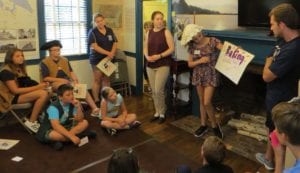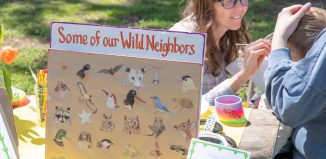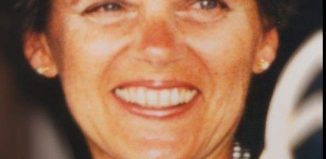Campers learn about spies at the Three Village Historical Society

By Beverly C. Tyler
Fifteen summer camp students ranging in age from 11 to 13, from Campus Camps in Oakdale, under the direction of Ashleigh Frezza, director, came to Setauket for a half-day spy school at the Three Village Historical Society’s history center. The students were ready to discover the story of the Revolutionary War Culper Spy Ring and to explore how the ring operated during the British occupation of Long Island and Manhattan.

The spy school program was designed to introduce students to each of the five main spies in the spy ring and how they operated between 1778 and 1783. Following a short PowerPoint presentation on the Culper Spy Ring, the students were divided into three groups. Each group of five students, together with an education leader, were provided with specific details of the operation of the spy ring. They studied the information until they understood the ring and were able to write about it and make presentations to the entire camp group at the end of the session.
The first group learned about each of the five principal members of the spy ring: Benjamin Tallmadge, Abraham Woodhull, Robert Townsend, Austin Roe and Caleb Brewster as well as the most important female who aided the ring, Anna Smith Strong. They also dressed in some of the clothing of the period and learned about a number of everyday items used and enjoyed by Long Islanders. When the entire camp met, each student, portraying a specific member of the spy ring, gave clues to the students in the other groups to see how long it would take to discover their identity.
The second group provided information about five various codes used during the Revolutionary War period, and the other students had to decipher a simple message presented by each student.
“They loved the codes and wanted more samples to decode,” said Donna Smith, TVHS education director. “I think they appreciated how long it might take to write a message in code and even to decode some of them.”
“I really enjoyed seeing how they were able to make predictions and were genuinely surprised when they realized how different the results were.”
— Lindsey Steward
The third group working with three different invisible ink liquids — lemon juice, milk and a solution of baking soda — presented their hypnosis as to which would prove to be the most effective invisible ink and their individual findings when they finished the experiment.
“I really enjoyed seeing how they were able to make predictions and were genuinely surprised when they realized how different the results were,” said Lindsey Steward, spy school leader.
Following the presentations, the students and their leaders went on a field trip to the Setauket Presbyterian Church graveyard and the Setauket Village Green. Here the students learned about conditions in Setauket and the Town of Brookhaven during the Revolutionary War. They explored part of the cemetery with special emphasis on the grave of Abraham Woodhull and the other Revolutionary War-era family sections that make up the earliest part of the graveyard. As they were leaving, I asked one student what she liked best about the day.
“I liked the trip to the cemetery, I liked everything,” the student said.
Beverly C. Tyler is Three Village Historical Society historian and author of books available from the society at 93 North Country Road, Setauket. For more information, call 631-751-3730 or visit www.tvhs.org.






